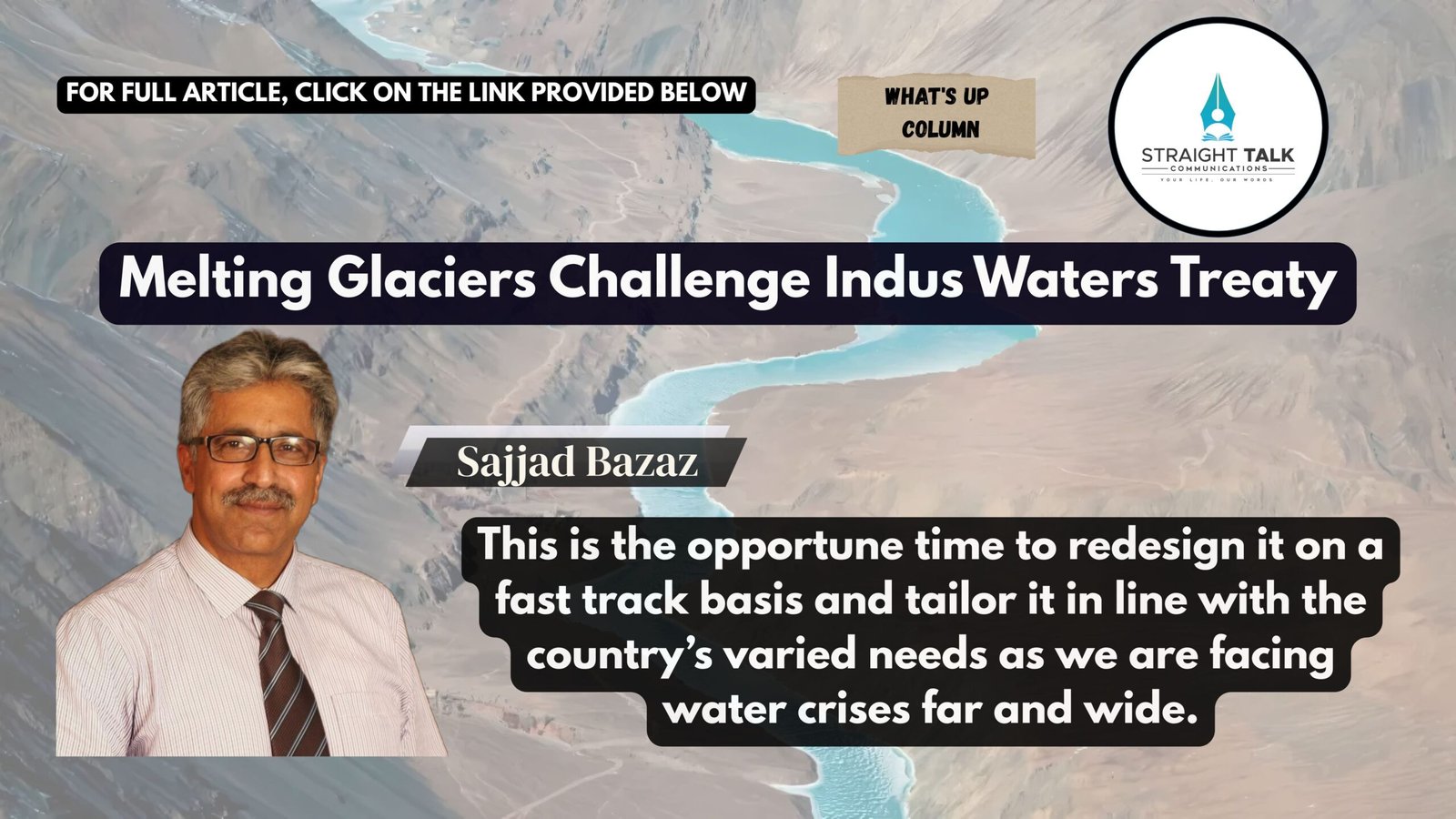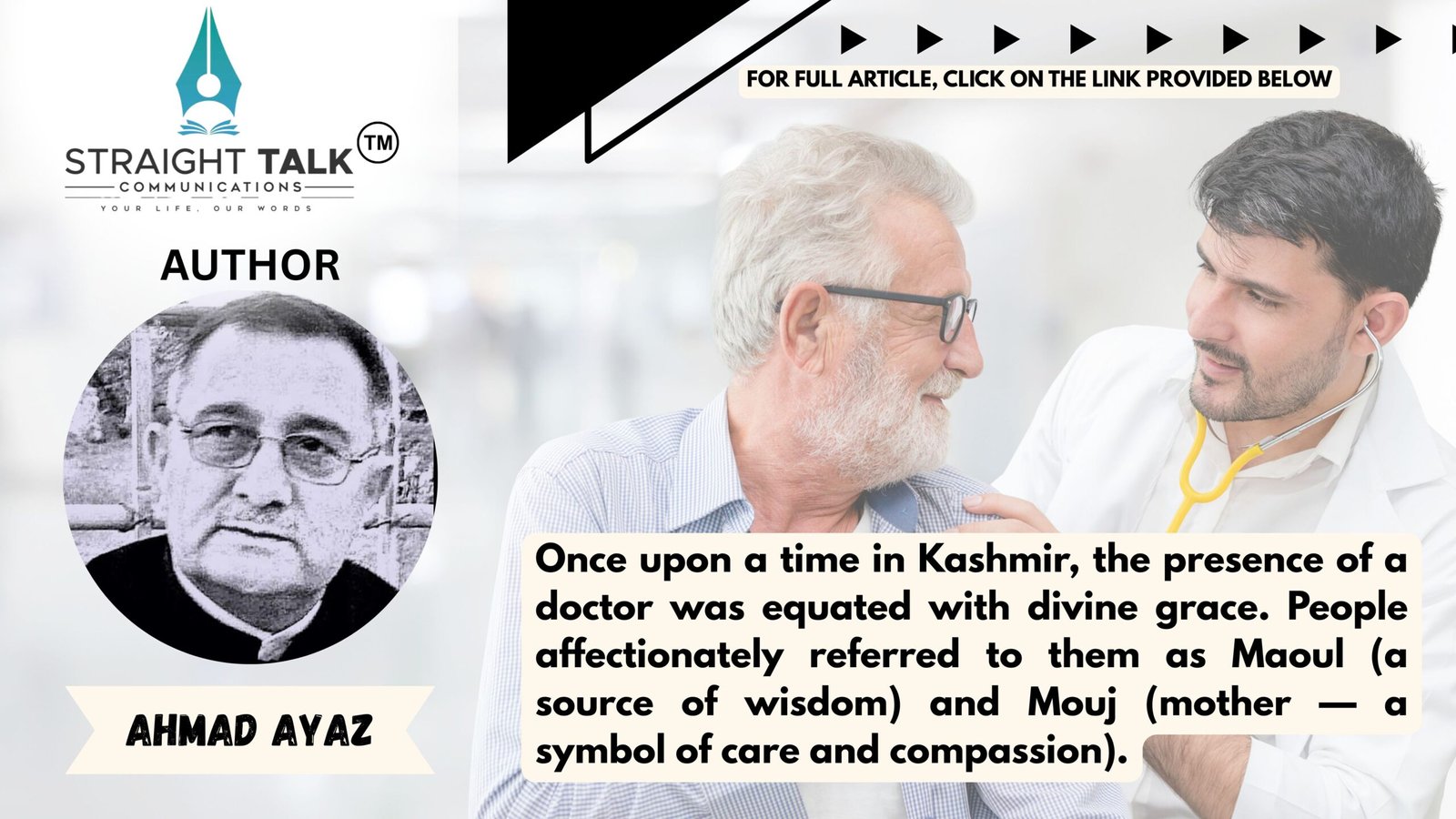Melting Glaciers Challenge Indus Waters Treaty

This is the opportune time to redesign it on a fast track basis and tailor it in line with the country’s varied needs as we are facing water crises far and wide.
Sajjad Bazaz
The Pahalgam terror attack on April 22 has brought global leaders on the same page; registering their strong resentment against this most heinous crime against humanity committed by the terrorists and their backers. India quickly responded with downgrading of diplomatic ties with Pakistan through several measures. The most significant move among others is ‘keeping the Indus Waters Treaty (ITW) in abeyance’.
Bringing the IWT into play as a diplomatic weapon to register stringent reaction against Pakistan for ‘orchestrating’ the Pahalgam terror attack, has once again brought ‘water politics’ into limelight.
Some time back, I came across a TV debate where debaters discussed ‘water weapon as an option with India to neutralise Pakistan’s might.’ Notably, “mutual trust and cooperation” has remained an important component for the Indus Waters Treaty (ITW) to work. And it is this component which India sees has been flouted by Pakistan time and again by peddling terrorism in Jammu and Kashmir.
The use of ‘water weapon’ means that any war between the two countries will not be this time to gain control over territory but to control water resources first.
The History Behind Indus Waters Treaty
The Indus River with a rich history of thousands of years since the Harappan civilisation, became a bone of contention immediately after the partition in 1947 when India and Pakistan emerged two separate nations. In 1948, water dispute surfaced for the first time when India temporarily halted water flow to Pakistan in 1948 and confrontations between the two neighbours continued at regular intervals which ultimately culminated in the signing of the Indus Waters Treaty in 1960.
Under the Treaty the waters of the Indus River and its tributaries (Jhelum, Chenab, Indus, Ravi, Beas, and Sutlej) were divided between the two countries. The control of the eastern rivers (Ravi, Beas, and Sutlej) was given to India, while Pakistan was granted rights over the western rivers (Indus, Jhelum, and Chenab). However, India was permitted limited use of the western rivers for “non-consumptive” purposes, such as hydroelectric projects.
Notably, the Treaty was brokered by the World Bank and was regarded as a successful international agreement, as it survived even two wars between the two countries in 1965 and 1971.
Does the Treaty Still Hold Ground?
Suspension of the Indus Water Treaty of course brought Pakistan’s role in the Pahalgam terror attack into the notice of the world community. What could be better than getting the Taliban-led Afghanistan government on the same page as they condemned the act of terrorism in the Pahalgam meadows killing at least 26 tourists. The suspension of the Treaty has already unnerved Pakistan with its Prime Minister Shahbaz Sharif’s office calling it as the usurpation of the rights of lower riparian and threatening it to be considered as an ‘Act of War and responded with full force.”
But the main issue with the Treaty for being used as a water weapon by India, is its validity in the given scenario – political as well as geographical scenario. Is the structure of the Treaty relevant after 65 years of its existence? At the time of its signing and bringing it into the force in 1960, this was seen as a fair solution as India and Pakistan were newly independent countries working to establish themselves. Back then, as per the facts and figures available in the archives, India’s population was 436 million and Pakistan’s population was 46 million. Today, India is a strong nation of 1.40 billion population and Pakistan’s population has surged to over 240 million. The Indus River Basin is a lifeline for over 300 million people for their survival. With the increased dependence on this precious water resource, it has become imperative to recognise that the actual challenge is the climate change which has triggered global warming and is fast resulting in the depletion of this precious water resource as glaciers are melting at faster rate on our side. In real terms, it challenges the existing Indus Waters Treaty. The melting glaciers have impacted (and continue to impact) the Indus water basin.
Going back into the parameters of the Treaty, we find that the melting of glaciers over a period of time was not factored in it. There is a lack of comprehensive studies on glacier mass balance when the Treaty was drafted. Let me explain ‘glacier mass balance’ in the words of a glaciologist. “The retreat of glaciers depends on the difference between how much snow and ice the glaciers receive and how much they snow and ice is lost to melting in summers, this is known as mass balance. If this is negative, the glaciers will retreat as there is more loss of snow and ice than gain.”
So, it was presumed in 1960 that the Himalayan glaciers, which feed the Indus River system, will always remain relatively stable. It has also been found that groundwater depletion, water pollution from pesticides, fertilizer use and industrial waste were not factored in the design of the Indus Waters Treaty. Even the experts have found the potential for large-scale hydraulic development through dams, reservoirs, canals and hydroelectricity missing in the Treaty.
Experts Speak
Today, the climate change which has drastically affected the stability of glaciers, has altered the hydrological patterns and are no longer persistent with the historic flows of rivers under the Treaty. Let it be on record at this point of time that the glaciers are now melting at record rates, which has almost drowned the Treaty.
Here it merits a mention of a powerful statement made by a leading glaciologist at IISc Anil Kulkarni. He says that India’s eastern Indus glaciers are melting faster than Pakistan’s and that will reduce water availability after mid-century. The glaciologist in an interview with the Indian Express explains that the “first important thing is to understand how climate is changing in the mountains, and how much is the glacier-stored water that feeds the river basin. He discloses that even though the original Treaty says that 20 percent of water is allotted to India, if you really look into the amount of glacial-stored water in say eastern river basins, it is not 20 percent but only 5%, and 95 percent of glacier water is stored in the western river basins. That means, there is a fundamental difference in the total availability of water.”
Notably, researchers have already warned that the Himalayan glaciers, which supply 60-70% of the Indus River’s summer flow, are shrinking rapidly. A 2019 study estimates they are losing 8 billion tons of ice annually.
This all means that the Treaty’s long-term effectiveness to ensure essential water for all the people who rely on the Indus River Basin is under threat in real sense. Even as it may temporarily increase river flow, it threatens the long-term availability of water.
Indeed, as per the expert analysis, if this trend continues, water shortages will intensify, particularly for Pakistan, which depends heavily on the Indus during dry seasons.
Conclusion
Keeping the Treaty in abeyance and using it as a ‘water weapon’ is a short-term measure. Of course, it can impart lessons to the neighbouring country as far as our concerns about terrorism are concerned. But, the strategy of using IWT should be long term in nature. This is the opportune time to redesign it on a fast track basis and tailor it in line with the country’s varied needs as we are facing water crises far and wide. This is also the time to accelerate our fight against climate change where depleting water resources owing to melting of glaciers is taken care of so that people don’t face food crises in the coming time. Building requisite infrastructure to store water and channel it for different needs is imperative. Review and redesigning of the Treaty needs to be in line with the Viksit Bharat plan. Re-strategizing to capitalise on the water resources and leveraging the natural flow of waters at this point of time will go a long way to support the nation to become a developed country by 2047.
To be precise, at this juncture when climate change is fast leading to depletion of water resources, the water management system through the IWT needs to be revisited and redesigned in a way that takes care of our future needs – to harvest prosperity, not poverty.
(The author is Editor-in-Chief of Straight Talk Communications. He is former Head of J&K Bank’s Corporate Communication & CSR Department and Internal Communication & Knowledge Management Department)







